Using AI for Interior Design: Tools, Benefits, and Limitations
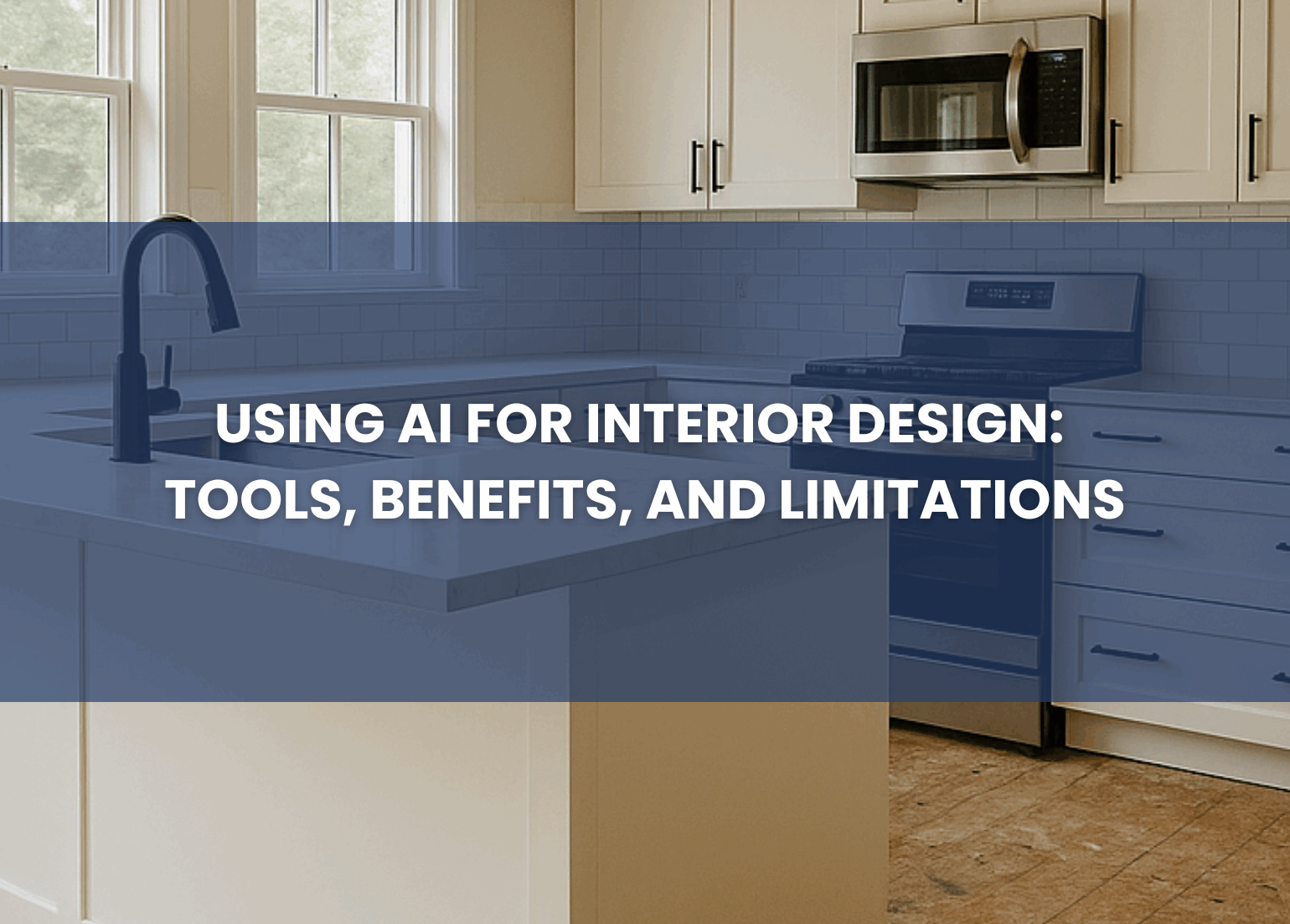
As artificial intelligence makes its way into the world of remodeling, many homeowners in Corvallis, Albany, and beyond wonder whether these AI interior design apps can help them reimagine their homes. At Thayer Design Build, we’ve been exploring a range of tools that promise to spark ideas and help visualize new layouts, wall configurations, and color palettes. AI can deliver quick concepts, but it can’t replace the local material and trades knowledge, personal experience, attention to detail, and personal guidance you get from working with a professional design‑build team. Let’s explore the AI interior design tools available today, highlight how they can support your remodeling journey, and clarify where the human touch remains essential.
AI Interior Design Tool Capabilities for Remodel Planning
Modern AI design programs offer a surprising amount of power for the early stages of ideating for a remodel. They can produce (mostly) photorealistic renderings of rooms with new floor plans or material combinations and suggest finishes that align with your personal style. A good example of this is shown below, where you see the real before photo of a space and then the ChatGPT version of that space when we give it commands to change layout, materials, and finishes to try to match renderings from our designer. Here’s a step-by-step of what we did, as well as what worked and what didn’t.
Here was our initial ChatGPT command:
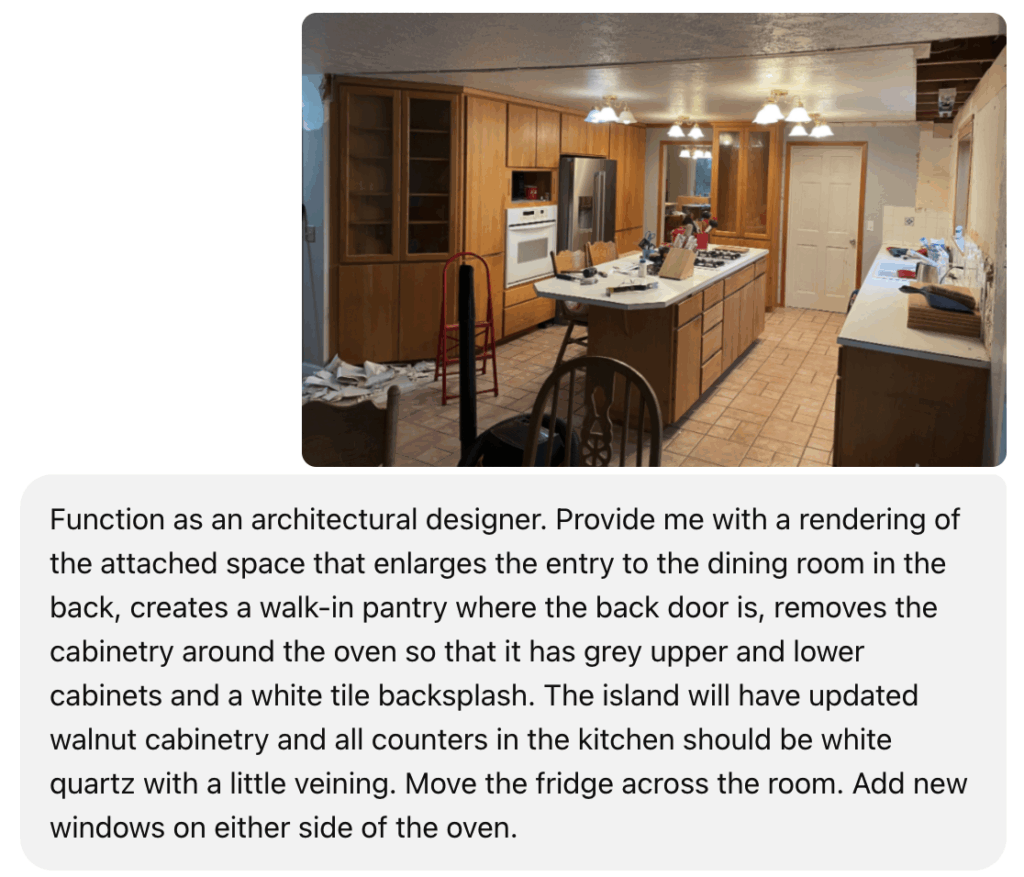
Here is what it produced:
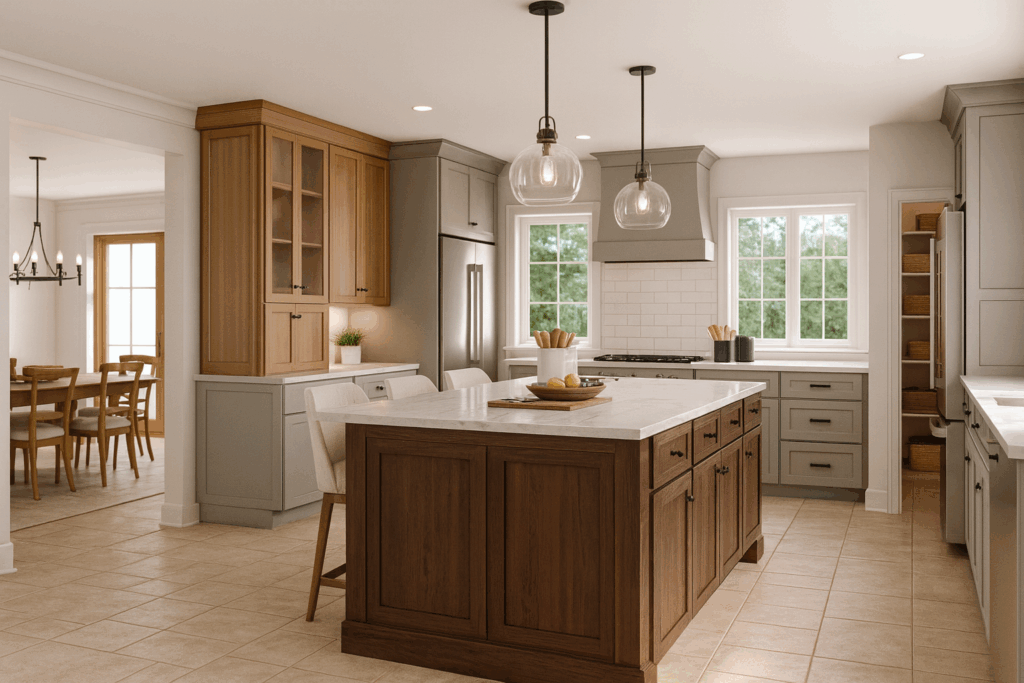
As you can see, it gives us some ideas for materials and finishes, but the layout wasn’t what we intended and there appear to be two fridges (one on the left and the right). So here’s the next command and the result it produced:
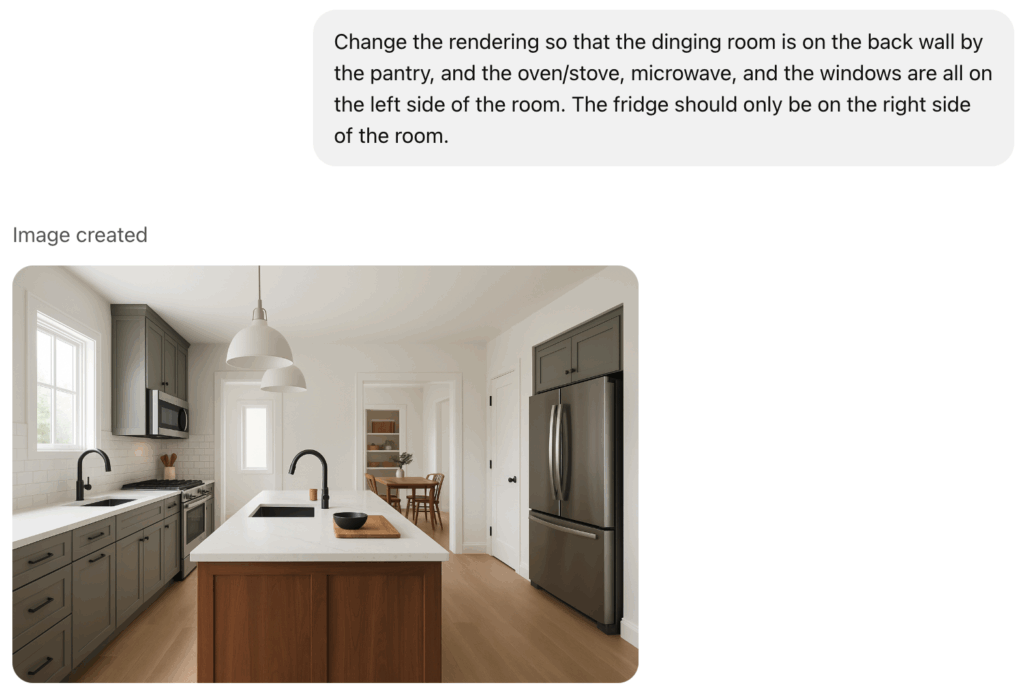
Obviously, this is very different from the image we provided to ChatGPT and the rendering that it had initially created. It has also now decided to swap the dining area with the “pantry” (if you can call it that), has put a sink under the window and another in the island, and there is an additional door next to the fridge. As you can see from the command above, none of those changes were requested.
We then decided to backtrack and change ONE thing to see how it would do, and this is what it produced:
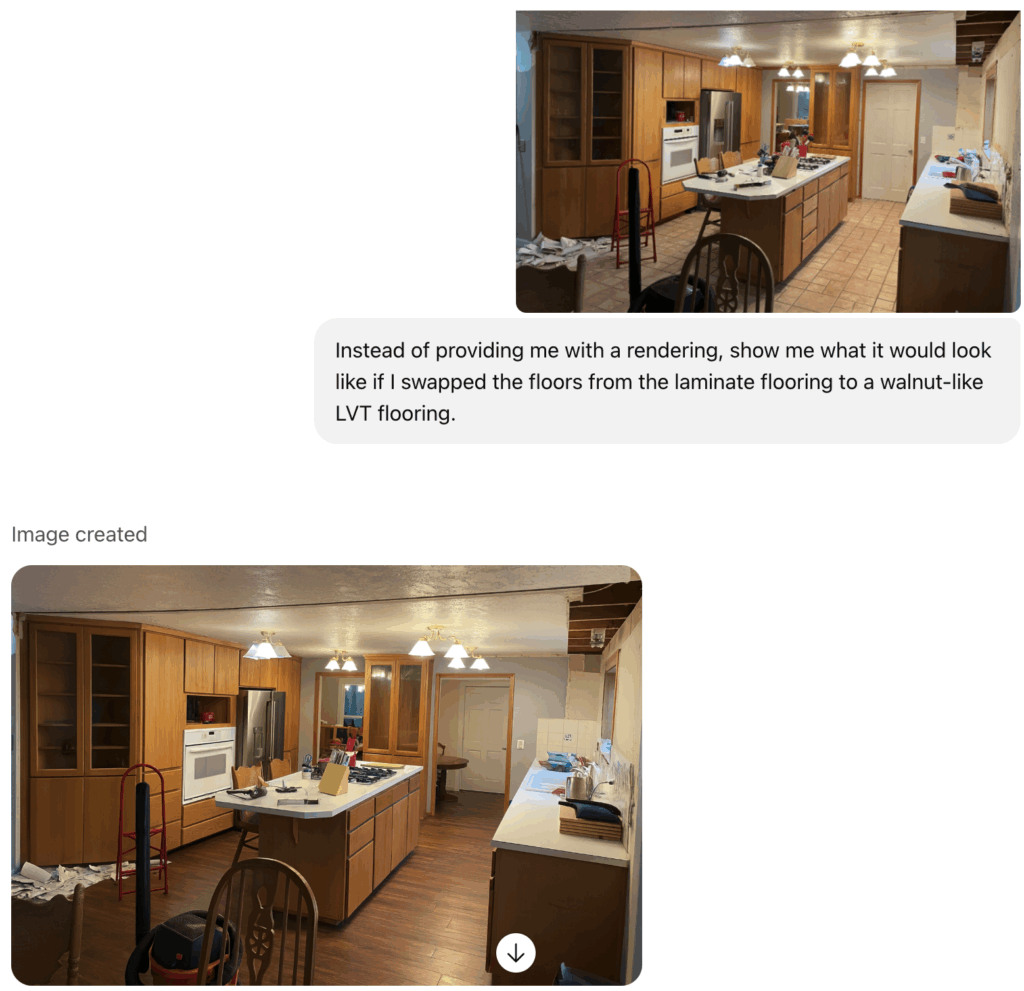
It DID replace the flooring with what we requested, but you’ll notice that it also decided to add an additional opening that leads to the back door and changed the appearance of some of the cabinetry.
Now, as you can see, ChatGPT can only do so much from a true design perspective. It’s limited in its understanding of our intention for the changes in the space, so a true designer would be required to get what we want to see visually accurate. It can, however, give us ideas if we want to just play with some options, like switching out materials to help envision how they’d look in a space.
ChatGPT is just one option for an AI remodeling tool and it’s currently the most accessible to non-designers. There are other applications that allow you to upload a floor plan and then test different wall placements, cabinet layouts, or counter heights. In contrast, others create mood boards and 3D models to help you explore colors, textures, and lighting options before construction begins. This visual sandbox makes it easier to communicate your vision to a professional and refine ideas, particularly if you have no clear preferences to begin with.
Popular AI Remodeling Tools
A handful of platforms stand out for homeowners and professionals alike. Unlike ChatGPT (used above), the following are specifically interior design AI programs and require paid subscriptions.
- Homestyler AI is easy to use and includes a broad library of fixtures, finishes, and design elements; its 3D visualization tools allow you to quickly experiment with new layouts and materials.
- Spacely AI caters to more complex remodels by letting you choose preset styles or upload reference photos, then fine‑tune the results. You can re‑render specific zones—such as moving a kitchen island or reconfiguring a shower—without starting over.
- Paintit.ai relies on a conversational interface: after you answer a few questions about your project, it produces concept renderings and supplies links to actual building products and fixtures, making it easier to shop for finishes that match your plans.
- If you just want a quick look at what’s possible, RoomGPT generates before‑and‑after images in seconds, offering a fun way to brainstorm remodel ideas.
Benefits of Using AI for Interior Design and Remodel Planning
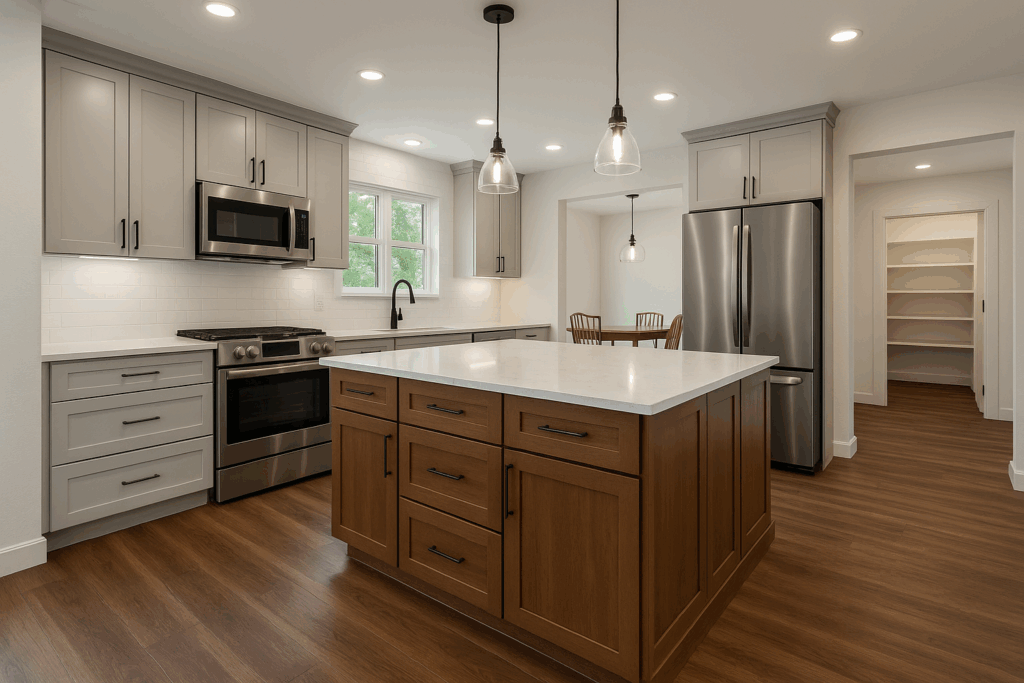
AI’s biggest advantage is speed. These tools can assemble room layouts and finish selections in minutes, helping you narrow down options (to an extent, depending on the options in their database) before meeting with a designer. Because most platforms offer free or low‑cost plans, they make early ideation and planning more accessible.
Many include budget‑planning features that allow you to enter a price range and receive suggested materials and fixtures within your budget. This feature can be especially helpful when you are trying to decide which type of contractor would be right for your home remodel.
Accurate scaling and visualization help ensure your new cabinetry or bathtub will fit, and you can refine ideas as many times as you like before reaching out to a designer or contractor. By the time you sit down with a professional, you’ll potentially have a clearer vision and a more confident sense of direction. Then, a designer can carry you through the rest of the process.
Limitations of AI Interior Design Tools for Remodel Planning
While AI software can be fun to experiment with, it has clear limits. The first issue is accuracy. Many apps struggle to keep proportions consistent and sometimes propose removing structural elements such as support beams or load‑bearing walls. They don’t account for the quirks and challenges of your existing home, so the final render can misrepresent room sizes or create impossible layouts. In other cases, the algorithms insert generic features because they’re programmed to push certain products, not because the items enhance the design. That might result in cabinets, fireplaces or fixtures that don’t fit your space or style.
AI also lacks the depth and nuance of a human designer. Even the most advanced programs can’t understand how you want to feel in your home, or tailor designs to your personal story. They can’t capture the layered textures, natural light, or custom details that make a remodel feel unique. And because their databases draw from broad trends, the outputs can look too perfect or unrealistic—like an image straight from a catalog rather than a space meant for real life (and especially your life).
Finally, these tools don’t know your local building codes, structural constraints, or material availability. They can’t coordinate electricians and plumbers, navigate permit approvals, or manage the supply chain. That’s where a trusted design-build team comes in. A professional can translate your AI-inspired ideas into a plan that reflects local requirements, complements your home’s architecture and aligns with your budget and timeline. The result is a remodel that’s both beautiful and buildable.
Finding the Right Balance Between AI Design and Human Experience
So when should you rely on AI, and when is it time to call in an experienced designer? If you’re curious about remodeling or have a small project—like experimenting with backsplash colors or exploring different cabinet configurations—using an app is a low‑risk way to play with ideas. It costs little or nothing, runs on your schedule and can help you get a feel for what’s possible in minutes. These tools work well for people who enjoy a do‑it‑yourself approach or who are looking for quick inspiration.
For larger, custom renovations, you need more than an algorithm. Design‑build professionals bring local codes, structural knowledge, material expertise, and creativity that AI simply can’t replicate. They listen to your story, incorporate sentimental pieces, adjust to unpredictable site conditions, and tailor the design to your lifestyle. A design-build company like ours also manages budgets, contractors, and schedules so you don’t have to.
That’s why the best approach is often a hybrid one: use AI to explore rough concepts, then partner with a design‑build team to turn those digital renderings into real, livable spaces. At Thayer Design Build, we embrace technology as a tool for collaboration. If you have AI mock‑ups or mood boards, bring them to your consultation. We’ll work with you to refine the layout, select quality materials, and create a remodel that reflects your vision.
The Future of AI and How It Affects Your Remodel Experience
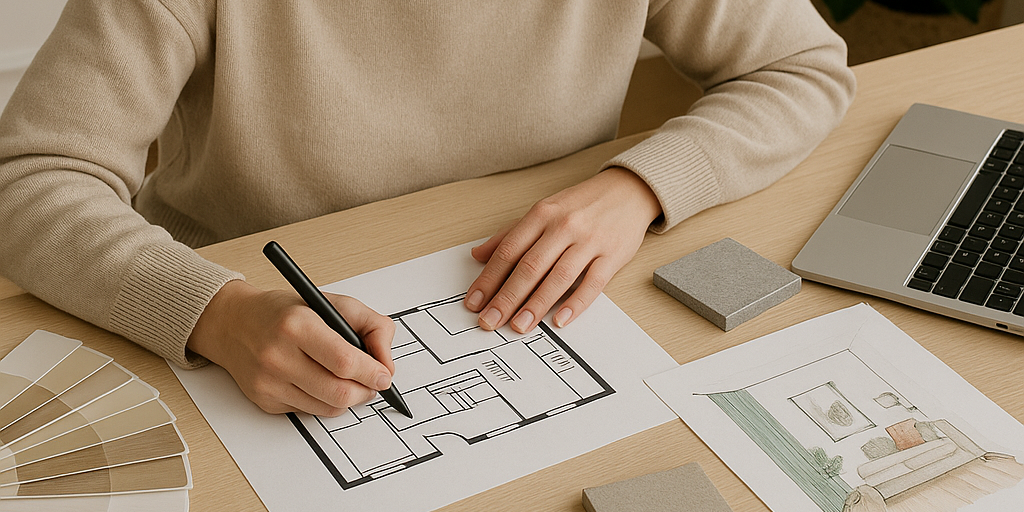
Artificial intelligence design tools have opened exciting new possibilities for anyone curious about remodeling. They provide rapid visuals and budget rough-outs, making it easier to imagine a new kitchen or bathroom before you even meet with a designer. Yet these apps are just one part of the journey. They can’t navigate local regulations, evaluate structural considerations, source artisan materials, or translate your personal story into a cohesive design.
That’s where a design-build partner shines. Thayer Design Build offers a one-stop design-build process that takes you from initial discovery through detailed design, construction and aftercare, all while providing a fixed-price agreement and accurate schedule. Our team protects your home during the build, handles permits and coordination, and stays in touch long after the dust settles with a 10-year limited warranty and regular follow-ups. We’re committed to listening to your needs, leveraging local trade relationships, and crafting spaces that feel like home for decades to come.
If you’re inspired by what you’ve seen in AI tools, bring those ideas to us. We’ll help you refine them, select materials that suit your lifestyle and budget, and manage every step of the remodel. Whether you’re dreaming of a modernized kitchen, an aging-in-place master suite, or a whole-home remodel, our goal is to make the process seamless and enjoyable. Reach out today to schedule a consultation and begin turning your vision into reality!